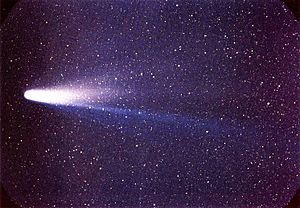Periodic comet facts for kids
A periodic comet is like a giant space snowball that travels around the Sun again and again. These icy visitors follow a special path called an orbit. We call them "periodic" because they come back to our part of the solar system regularly.
Contents
Types of Periodic Comets
Some comets have short trips around the Sun. They take less than 200 years to complete one orbit. These are called short-period comets. Other comets are long-period comets, and they take much longer, sometimes more than 200 years, to go around the Sun once. Some even take thousands of years!
How Comets Get Their Names
Most comets are named after the people who discover them. For example, the Shoemaker-Levy comets were named after Eugene Shoemaker, Carolyn Shoemaker, and David Levy. Sometimes, a comet is named after someone who figured out its orbit, like Comet Encke or Comet Crommelin.
It can be tricky to predict exactly when a long-period comet will return. This is because the gravity of large planets can affect their path. Also, gas and dust shooting off the comet itself can change its orbit slightly. However, short-period comets are much easier to predict, and we can often know exactly when they will appear.
Understanding Comet Names
Sometimes, different periodic comets might seem to have similar names. For instance, there are nine Shoemaker-Levy comets and twenty-four NEAT comets. To keep them organized, the Minor Planet Center, which is part of the International Astronomical Union, gives comets a special number before their name.
For example, 181P/Shoemaker-Levy and 192P/Shoemaker-Levy are both "Comet Shoemaker-Levy." Sometimes, people use an easier numbering system, so 181P might be called Comet Shoemaker-Levy 6, and 192P might be Comet Shoemaker-Levy 1.
The letter before the "/" in a comet's name tells us something important about it:
- C means it's a non-periodic comet. This means it might only visit our solar system once, or its orbit is very, very long.
- P means it's a periodic comet. This comet comes back regularly.
- D means the comet has been lost or has broken apart.
- X means we can't figure out a reliable orbit for it. This usually happens with very old, historical comets.
- A means the object was first thought to be a comet but turned out to be a minor planet (like an asteroid).
Some lists might keep the "C" prefix for comets with orbits longer than about 30 years until they are confirmed to return.
Related pages
See also
 In Spanish: Anexo:Cometas periódicos para niños
In Spanish: Anexo:Cometas periódicos para niños


